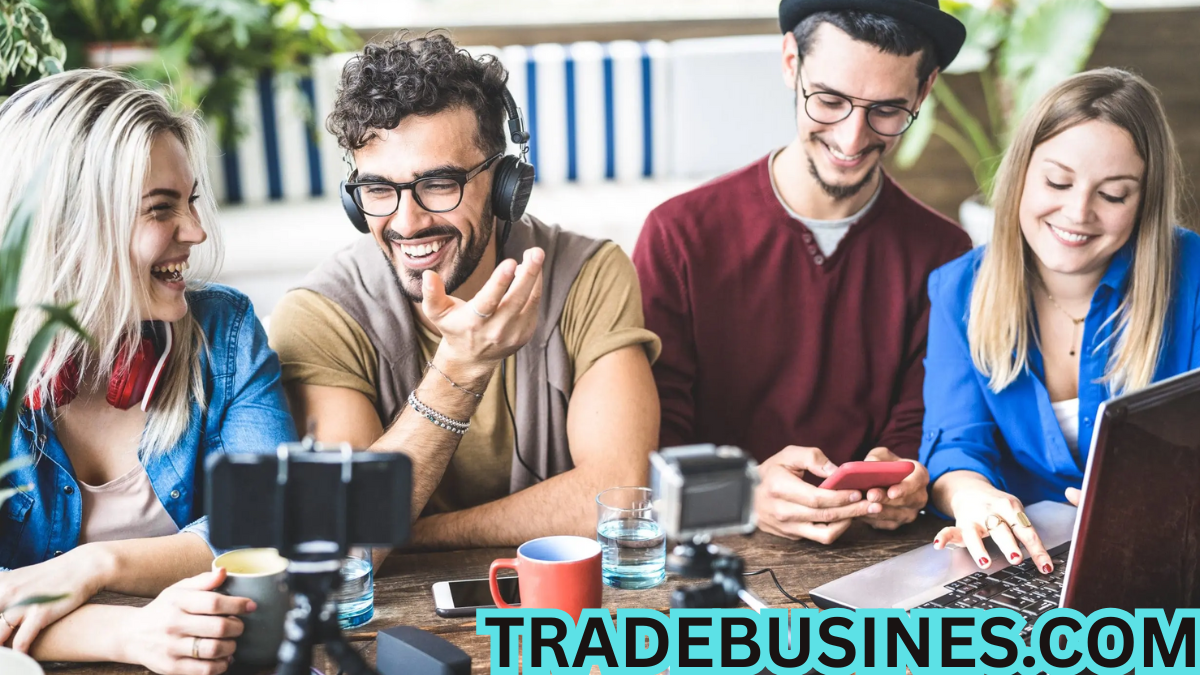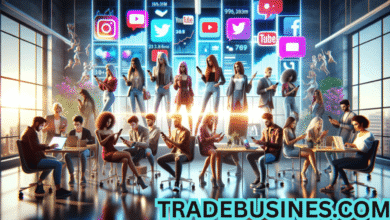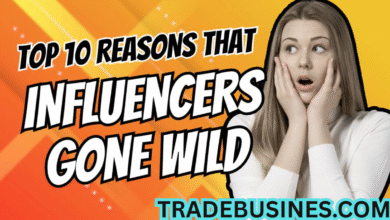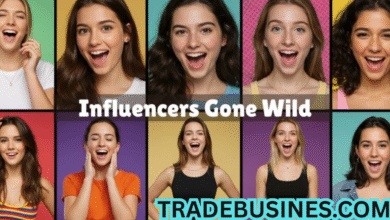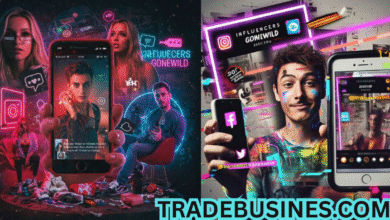The Era of Social Media Stardom
Influemcers Gonewild In today’s digital age, the rise of social media has created a new form of celebrity: the influencer. From makeup tutorials and fitness regimes to fashion hauls and prank videos, influencers have captivated millions with their charisma and seemingly relatable lifestyles. However, alongside this fame comes scrutiny, controversy, and sometimes, scandal. This phenomenon has birthed the term “influemcers gonewild,” a phrase capturing moments when influencers act unpredictably, unethically, or outrageously, often shaking the very foundations of their personal brands.
The concept reflects a broader societal tension where fame, public visibility, and accountability collide. When influencers cross the line or go off-script, it can result in viral backlash, media coverage, or even deplatforming. These moments often blur the line between entertainment and irresponsibility, raising important questions about influence, personal responsibility, and the effects of unchecked online power.
The Dynamics Behind Influencer Behavior
Understanding the psychological and social drivers behind influemcers gonewild requires a deep dive into the mechanics of online fame. Many influencers rise to prominence quickly, often without the training or preparation that traditional celebrities receive. They navigate massive audiences and sudden wealth, frequently without the backing of publicists, managers, or legal teams. This lack of infrastructure leaves them vulnerable to impulsive decisions that can tarnish their image.
The pressure to remain relevant is another significant factor. In the digital world, attention is currency. Influencers often feel compelled to push boundaries, embrace shock value, or stir controversy just to maintain visibility. Algorithms reward content that sparks engagement, and controversy is one of the most potent engagement drivers. This environment encourages increasingly risky behavior, contributing to the “gonewild” aspect of their persona.
Viral Moments That Shape Public Perception
What makes influemcers gonewild so compelling to the public is the unpredictability of it all. One moment, a creator is riding high with endorsements and ad revenue, and the next, they are the subject of widespread criticism. The spectacle of a fall from grace plays out in real time across platforms like Instagram, TikTok, and YouTube.
These incidents vary in intensity and impact. Some involve minor missteps blown out of proportion, while others reveal serious lapses in judgment or ethics. Regardless of scale, such moments feed the digital ecosystem’s insatiable appetite for drama. Commentators, fans, and critics alike dissect every detail, often spawning hashtags and reaction videos that add fuel to the fire.
The spectacle is not just about the initial act but the aftermath. How an influencer responds can either salvage or destroy their career. Apologies, public statements, and even silence all carry weight in determining public perception. Redemption is possible but often requires transparency, accountability, and a willingness to grow—traits not all influencers possess or exhibit when under pressure.
The Role of the Audience in the Influencer Ecosystem
Audiences play a pivotal role in the influemcers gonewild narrative. Consumers of content are not just passive observers; they are active participants in an influencer’s rise and fall. Fans often defend their favorite creators passionately, even in the face of compelling evidence of wrongdoing. At the same time, critics mobilize quickly to call out harmful behavior and demand accountability.
This duality makes online audiences both a protective shield and a destructive force. Influencers who cultivate loyal communities may find themselves insulated from criticism, while those who alienate followers face swift backlash. The dynamic is further complicated by the echo chamber effect, where influencers exist within curated digital bubbles that reinforce their views and behavior.
As audiences become more aware of their power, the concept of “cancel culture” continues to evolve. While some argue that calling out influencers is necessary for accountability, others believe it can be excessive and counterproductive. The debate highlights the tension between personal responsibility and public judgment in the influencer economy.
The Business of Influence and the Cost of Controversy
Behind every influencer is a network of business interests—sponsors, brands, platforms, and collaborators. When an influencer goes wild, the ripple effect touches all these stakeholders. Brands may pull sponsorships, platforms might demonetize content, and collaborators could distance themselves to protect their own reputations.
The financial implications can be devastating. Influencers who lose brand deals or get banned from platforms may struggle to regain their footing. Even worse, some find themselves involved in legal troubles or subject to civil litigation due to their actions. This high-stakes environment means that a single misstep can turn a profitable venture into a cautionary tale.
However, controversy can also be monetized. Some influencers capitalize on their notoriety, pivoting to new platforms or creating premium content around their most infamous moments. This commercialization of scandal raises ethical concerns and forces a reevaluation of what society rewards in the digital space.
Ethical Considerations in the Age of Influence
As influemcers gonewild incidents become more common, discussions about digital ethics gain traction. What responsibility do influencers have to their audience, especially younger viewers? Should platforms enforce stricter rules to curb harmful behavior, or does that infringe on creative freedom?
These questions are not easily answered, but they underscore the need for a framework that balances influence with accountability. Education on digital citizenship, mental health support, and transparency in advertising are just a few areas where improvements could be made. Encouraging responsible content creation requires a collective effort from platforms, creators, and audiences alike.
Ethical concerns also extend to the content itself. Some influencers, in pursuit of virality, engage in deceptive practices or promote harmful trends. From spreading misinformation to endorsing unsafe products, the consequences of such actions can be far-reaching. When these behaviors go unchecked, they erode public trust not just in individual influencers, but in the entire ecosystem of online content.
The Human Side of Public Failures
While the focus is often on the fallout, it’s important to remember that influencers are human. Many are young, inexperienced, and navigating immense pressure. Public failure can take a severe emotional toll, leading to anxiety, depression, and even withdrawal from public life.
Mental health support in the influencer community is often lacking. Despite the glamorous facade, many creators feel isolated, overworked, and underprepared to deal with the psychological effects of fame. The intense scrutiny that comes with going viral for the wrong reasons only amplifies these challenges.
Acknowledging the human side of influemcers gonewild doesn’t excuse bad behavior, but it does encourage a more compassionate and nuanced perspective. It also highlights the need for systemic change to better support those who work in the high-stakes world of digital content creation.
Cultural Reflections and Long-Term Implications
The phenomenon of influemcers gonewild reflects broader cultural trends. In many ways, it’s a mirror held up to society’s fascination with fame, scandal, and redemption. It also exposes the limitations of parasocial relationships, where audiences feel personally connected to influencers despite never meeting them.
These cultural shifts have long-term implications for how we understand celebrity, success, and accountability. As more people turn to social media as a career path, the line between public and private life continues to blur. The standards to which influencers are held will likely evolve, driven by shifting social norms, regulatory frameworks, and platform policies.
In the end, the story of influemcers gonewild is about more than individual missteps. It’s a reflection of a complex, rapidly changing media landscape where influence is both a gift and a burden. As audiences become more discerning and platforms mature, the hope is that the future of online influence will be one marked by responsibility, creativity, and authenticity.
FAQs About Influemcers Gonewild
What does “influemcers gonewild” mean?
The phrase refers to situations where influencers engage in controversial, outrageous, or irresponsible behavior, often resulting in public backlash, media attention, or a fall in popularity.
Why do influencers get into scandals?
Many influencers face pressure to stay relevant and popular, which can lead them to make impulsive or controversial decisions. A lack of professional guidance and the lure of viral fame can contribute to poor judgment.
How do audiences react when influencers go wild?
Audience reactions vary. Some fans defend their favorite influencers, while others criticize and demand accountability. Social media amplifies these reactions, often resulting in widespread discussions and debates.
Can influencers recover after a scandal?
Recovery depends on the nature of the scandal, the influencer’s response, and their audience’s willingness to forgive. Transparent apologies, accountability, and personal growth can help rebuild trust.
Are platforms doing enough to prevent unethical influencer behavior?
Many platforms have guidelines and policies, but enforcement is inconsistent. Critics argue for stronger regulations, while others advocate for creator education and audience empowerment.
Is the term “influemcers gonewild” meant to be negative?
Not always. While it often highlights negative behavior, it can also be used satirically or descriptively to refer to any extreme or unfiltered moment in an influencer’s public life.
How does this trend affect the future of influencer marketing?
Brands are becoming more cautious in Influemcers Gonewild selecting influencers, focusing on reputation, values alignment, and long-term partnerships to avoid being associated with controversy.
What can be done to reduce incidents of influemcers gonewild?
Improved mental health support, ethical training for creators, transparent platform policies, and critical media literacy among audiences can help foster a more responsible digital environment.
